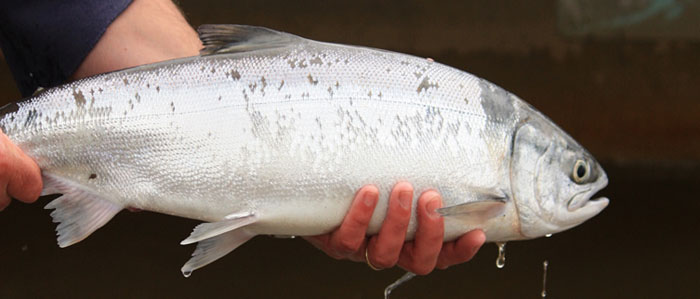
Nushagak River
Fish
The Fish
The Nushagak River contributes to the world's largest wild sockeye salmon fishery - Bristol Bay and also supports populations of chum, king, coho and pink salmon. The river may be best known for its king salmon. The Nushagak River hosts one of Alaska's biggest king salmon runs and produces more king salmon and pink salmon than any other river in the Bristol Bay region. Nushagak sockeye, king and chum salmon runs occur in June and July with considerable overlap in timing. Pink and coho salmon runs arrive in late summer, after most sockeye, chum and king salmon have already passed. Sonar site operations occur in June and July and produce estimate data for sockeye, king and chum salmon
Fishing
Nushagak salmon fisheries target primarily sockeye and king salmon. Sockeye are the primary species caught in the commercial fishery and also represent a substantial part of the subsistence fishery. King salmon provide subsistence fishermen with a valuable food source and sport fish guides and commercial fishermen with a valuable economic resource. In recent years there has also been a growing interest in coho and pink salmon as a commercial fishery. Of the three species monitored by the Nushagak sonar site, there are management plans for sockeye and king salmon, but not chum salmon.
King salmon management
The Nushagak River drainage king salmon fisheries management plan calls for a sustainable escapement goal of 40,000 to 80,000 fish and an inriver goal of 75,000 to provide subsistence and sport fishermen with harvest opportunities.
| King salmon catches (based on 20-year averages) | |||
|---|---|---|---|
| Commercial | Subsistence | Sport | |
| King | 53,000 | 13,191 | 5,913 |
Sockeye salmon management
The Nushagak River sockeye salmon fisheries management plan calls for a sustainable escapement goal of 340,000 to 760,000 sockeye salmon. But when the projected Nushagak sockeye run is less than 1.0 million fish and the ratio of Wood River to Nushagak River sockeye is greater than three to one, ADF&G manages the fishery based on a lower optimum escapement goal of 235,000 fish. The optimum escapement goal was determined by the Board of Fish to allow for greater opportunity for harvests of strong Wood River sockeye runs.




